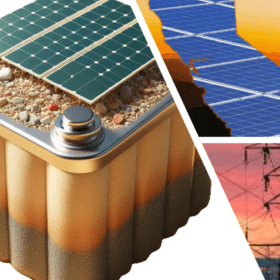California leads the nation in utility-scale solar power, boasting just under 47 GW of operational capacity generating over 68 GWh of electricity, and there was over 100 GW of new solar capacity in the utility queue at the end of 2023. This robust solar infrastructure is fueled by California’s abundant solar resources, positioning the state as a frontrunner in photovoltaic development. The surge in solar energy is anticipated to result in significant daytime generation surpluses, creating a ripe market for thermal energy storage (TES).
TES is strategically positioned to capitalize on the solar boom, benefiting from the synergies between solar and storage technologies. With over 10 GW of battery storage currently in operation and developers planning to add 68 GW this year, California leads the nation in this field as well. More than half of this storage capacity is integrated with other generation sources, predominantly solar. In fact, California accounts for over 80 percent of the operating battery energy storage system (BESS) capacity in the western U.S. and approximately half of the nation’s total installed storage capacity.
The impetus behind California’s renewable energy dominance stems from the state’s ambitious decarbonization objectives, aiming for 60 percent of retail electricity sales to be sourced from renewables by 2030 and achieving 100 percent carbon-free electricity by 2045. This drive has positioned California as a trailblazer in renewable energy deployment, ranking second only to Texas in combined wind and solar capacity, with nearly 25 GW currently operational. While 2.5 GW of wind power is in the pipeline for development in California, the solar pipeline dwarfs this figure by more than fourfold.
However, the saturation of the market with solar capacity poses a challenge to standalone solar projects, evident from the escalating curtailment rates observed in California. During 2023, renewable energy curtailment in the California Independent System Operator (CAISO) territory surpassed 2.5 million megawatt hours, primarily driven by solar oversupply.
The proliferation of solar energy presents lucrative opportunities for TES, particularly in energy arbitrage, where excess solar generation during daylight hours leads to lower energy prices, enabling cost-effective charging of storage systems. These stored energies can then be discharged into the grid during peak evening hours when energy prices are highest, maximizing returns for stakeholders. In 2022, more than 60 percent of new energy storage deployed on the grid was allocated for price arbitrage, with California accounting for a staggering 80 percent of that share.
BESS has been the conventional choice for energy arbitrage because batteries can quickly store and release energy, making it highly responsive to grid demands. However, it has several limitations, including high costs, limited lifespan and environmental concerns related to battery production and disposal. TES offers a compelling pairing proposition with distinct synergistic characteristics. TES systems store energy in the form of heat, which can be converted into electricity, which is often more cost-effective over the long term, as it can utilize materials such as sand, which is low-cost, easily accessible, thermally stable, non-toxic and environmentally friendly.
Geo2Watts™ is developing a Grid Sand Battery™ which is a novel concept for long-duration energy storage (LDES) using sand (silicon dioxide) that readily accepts and ejects heat. Sand has high heat capacity and is a cost-effective material to store thermal energy for months when contained underground. When the sun does not shine at night and on cloudy days, it continues to transfer heat with a closed-loop system for generating baseload and dispatchable electric power.
Another significant benefit of the Grid Sand Battery™ is its scalability and efficiency for storing vast amounts of energy for extended periods, making it ideal for balancing daily and even seasonal fluctuations in energy supply and demand. Additionally, this innovative technology can integrate seamlessly with existing BESS, thermal power plants, and renewable energy sources, enhancing their overall efficiency and output. Furthermore, the underground Grid Sand Battery™ does not compete for expensive aboveground real estate at the BESS site, can share existing power purchase agreements (PPAs) eliminating queue connection delays, and can share existing utility grid interconnection infrastructure.
Our research continues for developing additional novel designs using sand for TES exploiting its low-cost, easily accessible, thermally stable and non-toxic characteristics. Sand’s dual role as a heat transfer and insulating material is influenced by its porosity, granularity, moisture content and mineralogy. Sand with high quartz content, large grains, minimal porosity and significant moisture content is preferred for heat transfer, while dry sand with lower quartz content and higher porosity is better suited for thermal insulation. These unique characteristics open doors for innovative designs for enhanced efficiencies.
LDES will become increasingly more in demand for the California grid to complement short-term BESS due to its ability to provide extended energy backup during prolonged periods of low renewable generation. While BESS excels in short-term grid stabilization and managing daily energy fluctuations, LDES offers the capacity to store energy for days or even weeks. This is crucial for ensuring grid reliability during extended cloudy or windless periods, thereby supporting California’s ambitious renewable energy goals and enhancing resilience against outages and demand surges.
TES also aligns well with California’s climate and energy profile. The state’s abundant sunshine makes solar thermal energy a particularly suitable source for storing excess energy during the day and releasing it during peak evening hours for reducing reliance on fossil fuels and lowering greenhouse gas emissions.
Headline image courtesy of Geo2Watts.
Phil Cruver is a co-founder and CEO of Geo2Watts™. Previously, he was the founder and CEO of Catalina Sea Ranch, the first aquaculture facility in U.S. federal waters developed six miles offshore California. Cruver was also the founder of five additional start-up companies and recently served as Principal Investigator for over $1.2 millions of federally funded R&D projects. Cruver founded International Dynergy, a publicly traded company that installed 500 wind turbine generators in Palm Springs, California.






